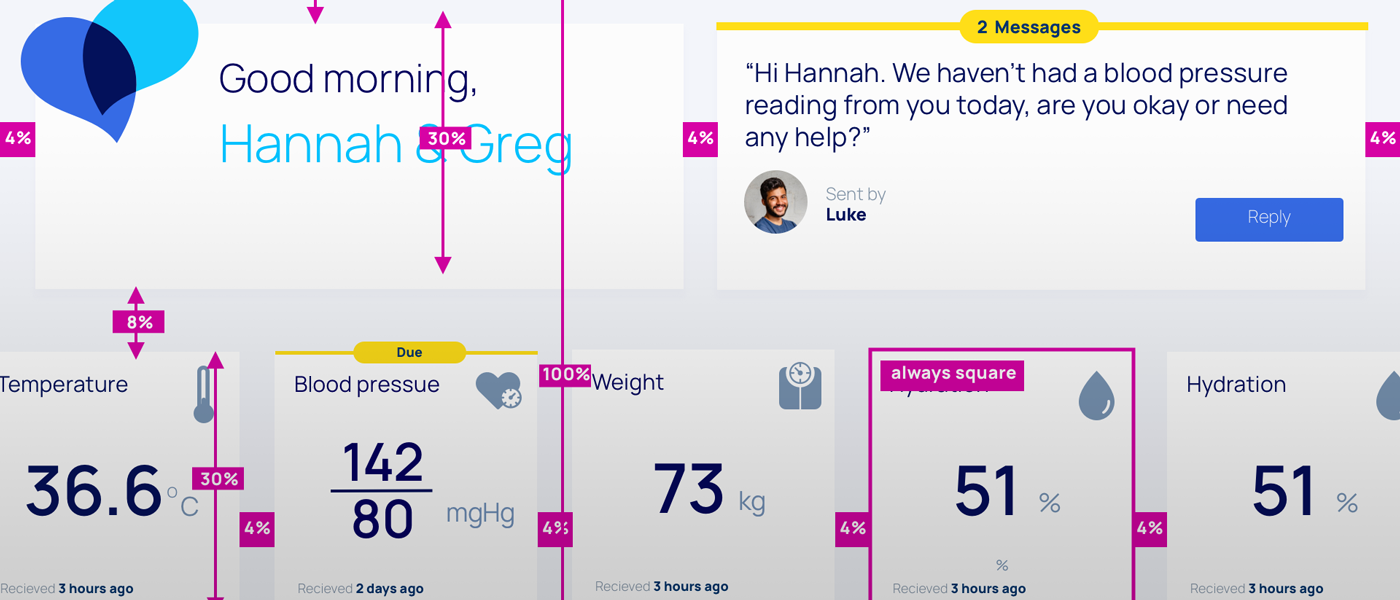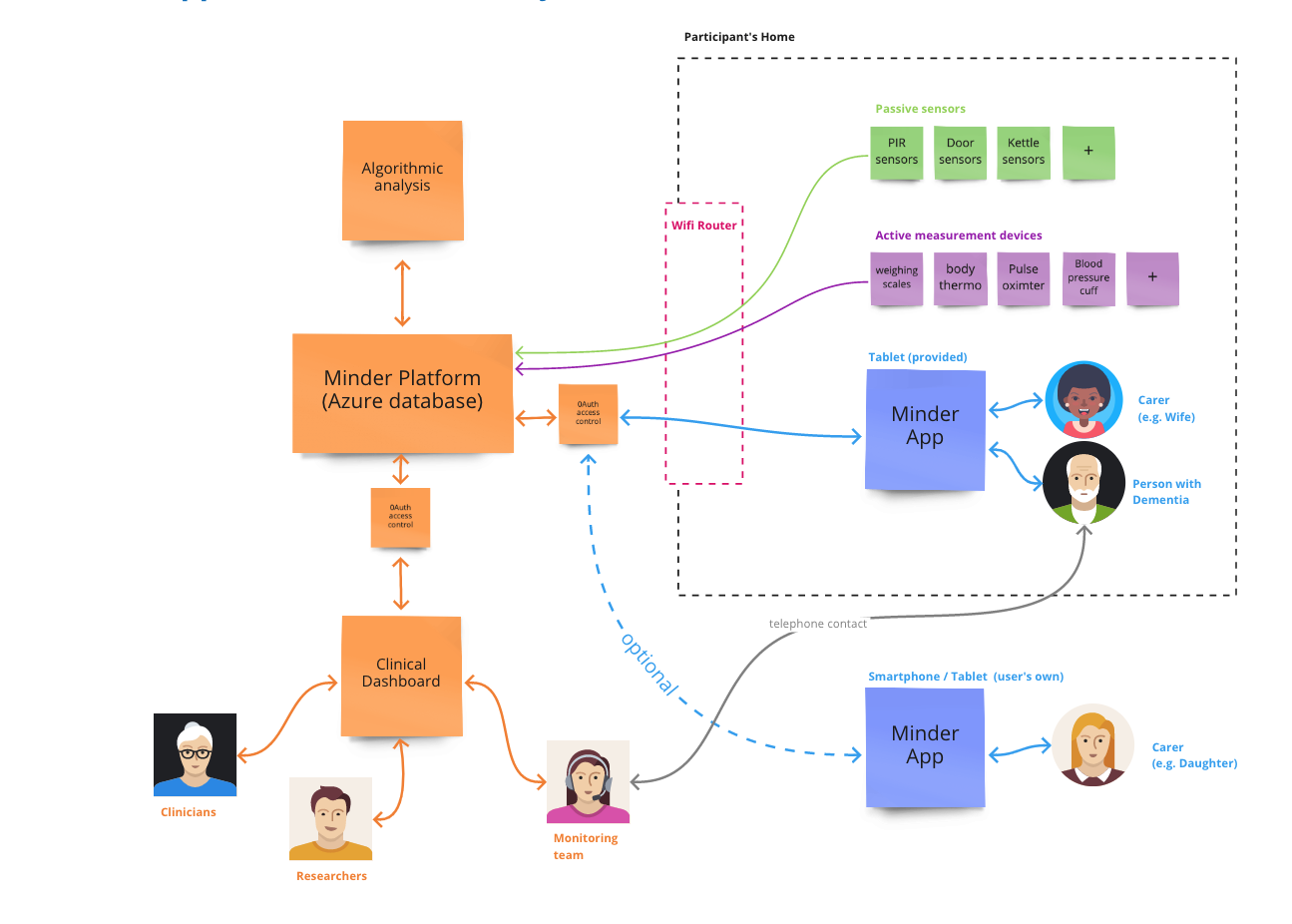
Minder App
Collaborators:
Matthew Harrison, Designer
Brian Quan, Front-end developer
Viktor Levine, Software Engineer
Pip Batey, Designer
Lenny Naar, Designer
Severin Skillman, Software Developer
and Minder Champions / research participants.
What is the need?
The starting point for a purpose made app for participants in the Minder study was an observation – while participants were taking measurements on wifi-enabled weighing scales, thermometers and blood pressure cuffs, they were also noting down the readings with pen and paper for their own reference. For example, they might want to take the data to a GP appointment or, have their own insight into changes over time.

Furthermore we were seeing low compliance in a ‘daily survey’ consisting of three well-being questions being delivered through an off-the-shelf app. These questions were seen as valuable by researchers as providing context to the environmental data collected passively from the home.
These two insights prompted us to rethink what the ‘active participation’ elements of the study could look and feel like when delivered through a purpose made app.
Project stage

What are the aims and objectives of the project?
The Minder App aims to be a useful, valuable tool for the study participants in order to improve the overall experience associated with being part of this research. This has the added benefit of being able to effectively collect data for research purposes and reduce dropout rates from the study.
This is achieved by making active participation easier, whilst providing additional benefits that assists with the daily routines of providing care for the person with dementia.
An example of the first instance is the way the app prompts participants to take measurements when needed, and provides feedback that the data is received. It also shows users their historical data for their own reference. The daily well-being questions were restructured to ensure that the questions felt relevant to users as well as researchers, were sensitive in the way they were phrased, and were efficient to answer.

To help with the daily routine of care, we included functionality such as daily reminders, with a simple interface, that can be used by participants to prompt activities such as medication, hydration, exercise etc.
We also introduced an observational diary, that allows carers in particular to record observations relating to dementia care. This can be a useful record for sharing with family or healthcare professionals. With each entry, the user can decide whether or not to share the observation with the researchers, so that they can actively communicate relevant observations to the study.
Plans for future development include daily care plans and information in the app that can assist with handing over care to new carers, for example if the carer becomes ill themselves, or the person is admitted to hospital or new care setting.
How was the project approached?
This project was driven from within the Helix design team within the Centre, and was designed and developed by Helix team members in consultation with stakeholders across the centre. The whole process has involved participants from the study to inform the design and ensure it was desirable to the end users.
What role does Patient and Public Involvement and Engagement (PPIE) play in this project?
The first insights that initiated the project were gained from visiting and spending time with participants in their own homes. We were able to do this before the COVID pandemic, and it proved highly valuable to gain a deep understanding of the variety of users’ needs within the Minder study.
As we designed and built the app, our ability to visit participants was curtailed by COVID19 lockdown restrictions, so we moved our PPIE and co-design activity online. We formed a weekly video conference session with a small group of interested participants. The group fed into many aspects of our work, providing feedback and ideas on the design of the Minder App as it was created.
The need to meet online proved fortuitous, in that it enabled regular shorter sessions, allowing a greater depth of involvement in the co-design process than we would have achieved through traditional house visits or in-person workshops. However the notable drawback was that we were limited to including participants and carers who were willing and able to use online video conferencing platforms.
What were the key insights to emerge?
Right from the start of the project, it was important to acknowledge that the app might not be appropriate to all participants, and that in most cases the likely primary user would be the carer rather than the person with dementia. However there are certainly cases where the dementia is less advanced where we anticipate the person with dementia using it themselves. The app has particular value in helping non-cohabiting carers (e.g. sons and daughters) look after someone while they remain in their own home.

However to address this we designed the app to be used by the ‘dyad’ – any combination of the carer and person with dementia. When you open the app it addresses both people. When responding to the daily well-being questions, we tailor the language to suit the person who is answering, whether carer answering questions about the person they care for, or the person answering questions about themselves. The app has also been built from the start to work across phones and tablets, on both android and iOS platforms.
Next steps
As the app has developed, and while the design team has been collaborating on other technology streams within the centre, it is clear that the potential for the app is advancing. Although the long term aims for technologies within the centre focus on automatic and passive experiences, to make them accessible and cost effective, the journey to that goal involves active participation to provide validating data as devices are introduced.
The app, sitting as a friendly and familiar device in each home, offers a platform to provide help and support to participants (e.g. help videos for specific interventions such as point of care UTI diagnostics) and a way to illicit contextual feedback as they experience the technologies (daily questions, and observation diary). We also anticipate deep integration between the app, and the robotic / voice interface work, as we design systems to cater for a range of abilities, providing choice in the ways users interact with the system.
The app is currently being deployed, and more information can be found in the resources for participants.
